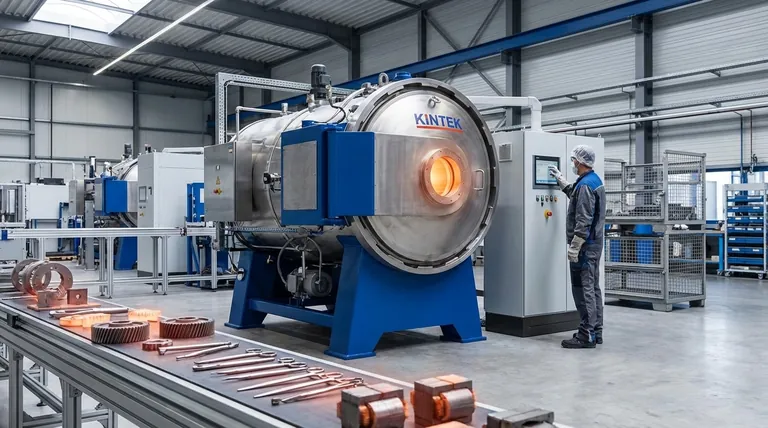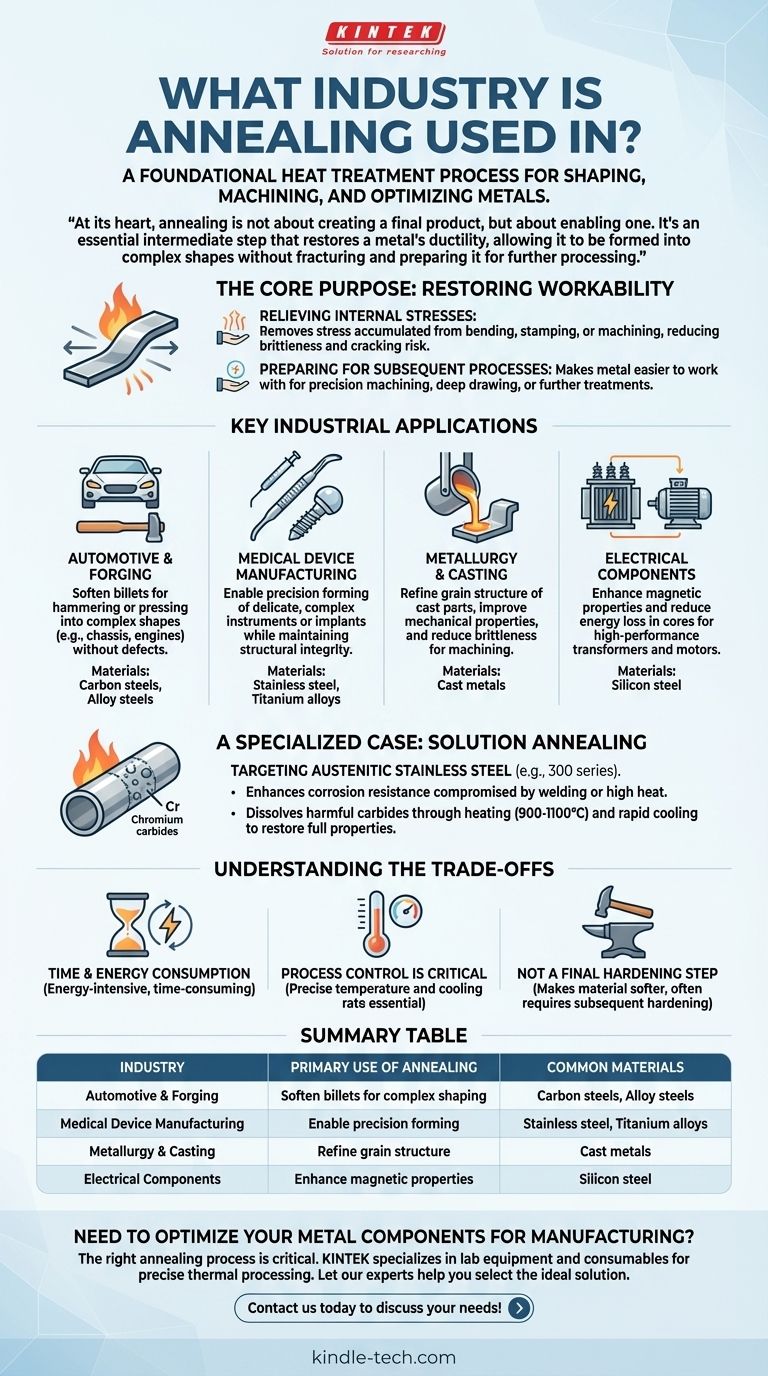Annealing is a foundational heat treatment process utilized in any industry where metals must be precisely shaped, machined, or optimized for specific properties. Its primary applications are found in the medical, automotive, forging, ferrous casting, and electrical manufacturing sectors for components like transformers and motors. The core purpose is to make a metal softer and more workable, preparing it for subsequent manufacturing steps.
At its heart, annealing is not about creating a final product, but about enabling one. It's an essential intermediate step that restores a metal's ductility, allowing it to be formed into complex shapes without fracturing and preparing it for further processing.

The Core Purpose of Annealing: Restoring Workability
The fundamental goal of annealing is to reverse the effects of processes that make metals hard and brittle, a phenomenon known as work hardening.
Relieving Internal Stresses
When metal is bent, stamped, or machined, it accumulates internal stress. This stress makes the material harder but also more brittle and prone to cracking.
Annealing involves heating the metal to a specific temperature and then slowly cooling it. This controlled thermal cycle allows the material's internal crystal structure to realign, effectively relieving stress.
Preparing for Subsequent Processes
A softened, stress-free metal is significantly easier to work with. Annealing is often performed to prepare a material for further operations like precision machining, deep drawing into complex shapes, or additional heat treatments to achieve final desired properties.
Key Industrial Applications
While the principle is universal, its application is tailored to the unique demands of different industries.
Automotive and Forging
The automotive industry relies on forming complex metal parts for chassis, engines, and drivetrains. Forging operations use annealing to soften metal billets, allowing them to be hammered or pressed into intricate shapes without developing defects.
Medical Device Manufacturing
Medical devices demand high precision and reliability from materials like stainless steel and titanium alloys. Annealing is used to ensure these metals can be formed into delicate and complex instruments or implants while maintaining their structural integrity.
Metallurgy and Casting
In foundries and casting operations, annealing is used to refine the grain structure of cast parts. This process improves their mechanical properties, reduces brittleness from the casting process, and makes them suitable for machining.
Electrical Components
For applications like electrical transformers and motors, annealing serves a dual purpose. It not only improves the workability of the silicon steel used for the core but also enhances its magnetic properties, reducing energy loss and increasing efficiency.
A Specialized Case: Solution Annealing
While standard annealing focuses on softening, specialized versions exist to achieve different outcomes. Solution annealing is a prime example used almost exclusively with certain types of stainless steel.
Targeting Austenitic Stainless Steel
This process is specifically applied to 300 series stainless steels. These materials are prized for their excellent corrosion resistance, but this property can be compromised during fabrication.
Enhancing Corrosion Resistance
Welding or other high-heat processes can cause chromium carbides to form within the steel's structure, depleting chromium and creating weak points for corrosion.
Solution annealing heats the steel to a high temperature (typically 900-1100°C) to dissolve these harmful carbides. It is followed by rapid cooling, which locks the elements in place and restores the material's full corrosion resistance and ductility.
Understanding the Trade-offs
Annealing is a powerful tool, but it's essential to understand its practical implications and limitations.
Time and Energy Consumption
Heating large metal parts to very high temperatures is an energy-intensive and time-consuming process. This adds significant cost and time to the manufacturing cycle, which must be factored into production planning.
Process Control is Critical
The effectiveness of any annealing process depends entirely on precise control over temperature and cooling rates. Improper control can fail to relieve stress, or worse, create undesirable material properties that defeat the purpose of the treatment.
Not a Final Hardening Step
It is crucial to remember that annealing makes a material softer. If the final part requires high strength or hardness, annealing serves only as an intermediate step. A subsequent hardening heat treatment will almost always be necessary.
Making the Right Choice for Your Goal
Selecting the correct thermal process depends entirely on the material you are using and your desired outcome.
- If your primary focus is manufacturability: Use standard annealing to soften carbon steels, aluminum, or copper, making them easier to form, machine, or draw into complex shapes.
- If your primary focus is peak corrosion resistance in stainless steel: You must use the specific process of solution annealing to dissolve chromium carbides and restore the material's inherent protective qualities.
- If your primary focus is electrical efficiency: Employ annealing on silicon steel to refine its grain structure and optimize the magnetic properties required for high-performance motors and transformers.
Ultimately, understanding the specific purpose behind annealing allows you to select the right thermal process to achieve optimal material properties for any application.
Summary Table:
| Industry | Primary Use of Annealing | Common Materials |
|---|---|---|
| Automotive & Forging | Soften billets for complex shaping | Carbon steels, Alloy steels |
| Medical Device Manufacturing | Enable precision forming of delicate parts | Stainless steel, Titanium alloys |
| Metallurgy & Casting | Refine grain structure and reduce brittleness | Cast metals |
| Electrical Components | Enhance magnetic properties and efficiency | Silicon steel |
Need to optimize your metal components for manufacturing? The right annealing process is critical for achieving the desired softness, workability, and material properties. KINTEK specializes in lab equipment and consumables for precise thermal processing, serving industries from medical to automotive. Let our experts help you select the ideal solution for your specific material and application. Contact us today to discuss your needs!
Visual Guide

Related Products
- Vacuum Heat Treat Sintering Brazing Furnace
- Vacuum Heat Treat Furnace with Ceramic Fiber Liner
- Molybdenum Vacuum Heat Treat Furnace
- 2200 ℃ Tungsten Vacuum Heat Treat and Sintering Furnace
- Graphite Vacuum Furnace High Thermal Conductivity Film Graphitization Furnace
People Also Ask
- What is the process of a vacuum furnace? Achieve Purity and Precision in High-Temp Processing
- Can dissimilar metals be brazed or braze welded? A Guide to Strong, Reliable Joints
- What is vacuum brazing? The Ultimate Guide to High-Purity, Flux-Free Metal Joining
- What is the difference between welding and vacuum brazing? Choose the Right Joining Method for Your Project
- What is a vacuum furnace used for? Unlock Purity in High-Temperature Processing



















